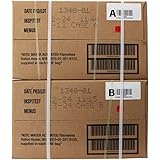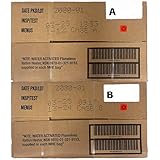Food and Water Supplies
Determine Your Needs
First things first, you gotta know how much food and water you need to ride out a situation. When I’m planning out my bug-in scenario, I consider how many people will be at home. It’s crucial to calculate the daily water intake and food requirements for each member of the family. I typically aim for at least a gallon of water per person, per day, just to be safe.
Next, I think about what types of food we enjoy and can store easily. Canned goods, dried fruits, and freeze-dried meals are my go-tos. They last a while and don’t require refrigeration. I usually try to have at least a two-week supply of food on hand — it really eases my mind when I know I have enough to last.
Lastly, I always have a few treats in my stash. It sounds small, but it can really lift the spirits when times are tough. A little chocolate or some snacks can make a huge difference and remind everyone that even during serious situations, we can still have some fun!
Medical Supplies
Basic First Aid Kit
Trust me, having a solid first aid kit is non-negotiable. I’ve had situations where my kids fall and scrape their knees, and I’m so grateful to have antiseptic wipes, band-aids, and ointments ready to go. It’s a good idea to have a well-stocked first aid kit at home and throw in some extra things, like gloves and gauzes, which can come in handy for more serious injuries.
I’ve also invested in some essential over-the-counter medications. Pain relievers, allergy meds, and cold medicine are staples. Keeping track of expiration dates is super important, though! There’s nothing worse than reaching for something only to find it’s old and expired when you really need it.
Apart from the basic kit, I keep a personalized list of anything specific to our health needs. If someone has a chronic condition or needs specific medication, ensure you have enough on hand for the duration you anticipate needing it. It’s all about being prepared so that everyone’s health is prioritized during uncertain times.
Tools and Equipment
Prepare for Power Outages
When I think about bugging in, I consider how to continue functioning without our regular power sources. Having a reliable flashlight, extra batteries, and candles can really help during those unexpected blackouts. I keep a couple of solar-powered lamps in the mix too, which have been a game-changer!
Also, I can’t stress this enough: have a multi-tool handy! You can’t imagine how often I’ve reached for it for quick fixes around the house or in the yard. They’re versatile tools that can serve multiple purposes and are super compact, making them easy to store.
== > What if ... Get a FREE Subscription to PREPARE
Don’t forget about kitchen gear, whether it’s a portable stove or a backup grill. Cooking meals can become a chore if everything’s taken away from us. I keep a camp stove stored away for such occasions, and it really helps to have something like that when those times arise.
Communication Plans
Staying In Touch
In any emergency, you need to know what’s going on, right? I’ve set up a communication plan with family and friends just in case things spiral out of control. It’s important to designate a safe location for your loved ones to meet if something were to happen.
Get Preparedness and Self-Reliance Tips. Subscribe Now!
I also like to keep a battery-operated radio on hand. It can be a lifesaver for staying informed about local news when there’s no electricity or internet. Plus, it doesn’t hurt to have an emergency charger for your phone. I keep a power bank with solar charging capabilities, so I can keep my devices alive!
Lastly, I make it a point to regularly check and practice our communication plans. That way, if the time comes, everyone knows their roles and responsibilities without panic setting in. Our family meetings have actually turned into fun bonding moments, which is a nice little perk!
Security Measures
Fortifying Your Home
Alright, let’s be real for a second: safety is a top priority when you’re bugging in. I take a good hard look at all points of entry in my house and ensure things are secure. It doesn’t have to be a complete fortress, but I want to deter any potential threats.
I have cameras installed around the house and motion lights on the exterior. I can tell you from personal experience that this gives me peace of mind that when things get hectic, I can keep an eye on what’s going on outside without putting myself at unnecessary risk.
Additionally, I’ve involved family in discussions about safety protocols, so we’ all on the same page. Knowing when to lock doors, avoid certain areas, or even how to respond to unknown visitors is something every member of the family should be in the loop about. Strengthening our security isn’t just about equipment; it’s a mindset that we all practice together.
FAQs
What is a bug-in plan?
A bug-in plan is a strategy for staying safely at home during an emergency. It involves being well-prepared with essential supplies, medical needs, and security measures.
How long should my food supplies last?
It’s generally advisable to have at least a two-week supply of food and water. This ensures that you’re covered in most emergency situations.
What items should be included in a first aid kit?
Essential items include antiseptic wipes, band-aids, gauze, pain relievers, and any specific medications for chronic conditions. Tailor it to your family’s needs!
Why is a communication plan important?
Having a communication plan ensures that all family members know where to go and how to stay in touch during an emergency. It reduces panic and helps everyone stay connected.
How can I secure my home during an emergency?
Fortifying your home can include installing locks on windows and doors, setting up security cameras, and discussing safety protocols with your family members.
Get Preparedness and Self-Reliance Tips. Subscribe Now!
Related Content
Wornick Sopacko, Ameriqual MRE Meals Ready to Eat Inspection 2025, 2026 or Better, Emergency Food Supply, Survival Camping Outdoor 12 Pack(A & B Case Bundle, 2, Count)
Now retrieving the price.
(as of December 25, 2025 18:19 GMT -05:00 - More infoProduct prices and availability are accurate as of the date/time indicated and are subject to change. Any price and availability information displayed on [relevant Amazon Site(s), as applicable] at the time of purchase will apply to the purchase of this product.)





